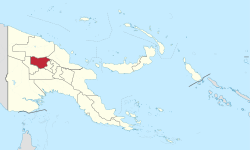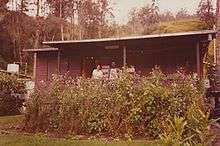Enga Province
| Enga Province | ||
|---|---|---|
| ||
 Enga Province in Papua New Guinea | ||
| Coordinates: 5°25′S 143°30′E / 5.417°S 143.500°E | ||
| Country | Papua New Guinea | |
| Capital | Wabag | |
| Districts | ||
| Government | ||
| • Governor | Peter Ipatas 1997- | |
| Area | ||
| • Total | 11,704 km2 (4,519 sq mi) | |
| Population (2011 census)[1] | ||
| • Total | 432,045 | |
| • Density | 37/km2 (96/sq mi) | |
| Time zone | AEST (UTC+10) | |
Enga is one of the provinces in Papua New Guinea (PNG). It is located in the north most region of the highlands of PNG, having been divided from the Western Highlands to become a separate province when the provinces were created at the time of independence in 1975. The people of Enga are called Engans—they are a majority ethnic group—speaking one language in all its five districts: approximately 500,000 people. A small minority of Engans' land on the eastern side of the region remained in the Western Highlands, their territory being accessible by road from Mount Hagen but not directly from elsewhere in Enga territory.
Physical geography

Enga is the highest and is the second most rugged province (after Simbu Province) in Papua New Guinea. It covers an area of 2,800 km². Much of the province is at altitudes of over 2000 metres. Lower altitude areas are typically valleys which form the watershed for the two major river systems that drain the province, the Lagaip (which is a tributary of the Fly) and the Lai (which is a tributary of the Sepik).
Human geography
The Papua New Guinea census of 2000 lists the population of Enga at 295,031 people, although the accuracy of the census is questionable. The provincial capital of Enga is Wabag. The two other main centres of population are Wapenamanda and Laiagam. Porgera, at the western edge of the province, is home to a gold mine operated by Barrick Gold.
Enga is unique among the provinces in Papua New Guinea in that it has only one major linguistic and ethnic group: Enga speakers. Although dialects of the Enga language vary greatly from Laiagam in the west to Wapenamanda in the east, Engans' shared ethnic identity overshadows the existence of other ethnic groups in the province, such as Ipili speakers (around Porgera) and Nete speakers.
Districts and LLGs
Each province in Papua New Guinea has one or more districts, and each district has one or more Local Level Government (LLG) areas. For census purposes, the LLG areas are subdivided into wards and those into census units.[2]
| District | District Capital | LLG Name |
|---|---|---|
| Kandep District | Kandep | Kandep Rural |
| Wage Rural | ||
| Kompiam District | Kompiam | Ambum Rural |
| Kompiam Rural | ||
| Wapi (Uangis) Rural | ||
| Lagaip-Porgera District | Laiagam-Porgera | Pilikambi Rural |
| Maip-Mulitaka Rural | ||
| Paiela-Hewa Rural | ||
| Porgera Rural | ||
| Wapenamanda District | Wapenamanda | Wapenamanda Rural |
| Tsak Rural | ||
| Wabag District | Wabag | Maramuni Rural |
| Wabag Rural | ||
| Wabag Urban[3] |
Politics
Politics of Enga Province comprises the Governor and 5 Open MPs. The provincial assembly is headed by the Governor Chief Peter Ipatas.
Members of the National Parliament
The province and each district is represented by a Member of the National Parliament. There is one provincial electorate and each district is a local ("Open") electorate. The following table lists Members before and after the 2012 general election.[4]
| Electorate | Previous member (party) | 2012 winner (party) |
|---|---|---|
| Enga Provincial | Peter Ipatas(PP) | Peter Ipatas (PP) |
| Kandep Open | Don Polye(THE) | Don Polye (THE) |
| Kompiam - Ambum Open | John Pundari (PP) | John Pundari(PP |
| Lagaip - Porgera Open | Philip Kikala (NA) | Nixon Mangape (Independent) |
| Wapenamanda Open | Miki Kaeok (NA) | Rimbink Pato (UP) |
| Wabag Open | Sam Abal (NA) | Robert Ganim (PP) |
Culture

Like many other highland Papua New Guineans living west of the Daulo Pass (between Simbu Province and Eastern Highlands Province), the traditional Engan settlement style is that of scattered homesteads dispersed throughout the landscape. Historically sweet potato was the staple food, sometimes supplemented by pork. The modern diet places an increasing emphasis on store bought rice and tinned fish and meat. Pigs remain a culturally valued item with elaborate systems of pig exchange also known as "tee" that mark social life in the province.
Traditional Engan culture practiced strict segregation of sexes. During initiation young men between the ages of 16 and 19 were purified in seclusion at a ceremony called the "sangai," in which their eyes were ritually washed with water, to remove any taint resulting from contact with females, and where they prepared traditional finery, the most notable item being a wig made out of their own hair. This distinctive round wig topped with sicklebird feathers is, more than any other item, an icon or symbol of Engan culture today.
Today the most popular religious groups are the Catholic Church, the Gutnius Lutheran Church, the Baptist Union and the Seventh-day Adventist Church. Charismatic and Pentecostal movements are growing in popularity.
The lifestyle and customs of the Enga people were extensively studied and reported upon by the American anthropologist Mervyn Meggitt.
Kompiam is another District located on the Northern edge of Enga Province as Maramuni, a sub-District of Wabag District situated a head of Kompiam sharing border with East Sepik Province. Both Kompiam and Maramuni do share the Physical geography, human geography and culture with the entire Enga Province.
Traditional architecture
For centuries Engans have constructed dwellings made from locally available bush materials. Roof construction is often of a crude thatch type, waterproofing being obtained by repeated lighting of a heavily smoking fire inside and the accretion of the soot onto the roofing material.
Floors are often dirt, covered with a semi-disposable woven layer of bush material. Sugarcane husks are also spread across the dirt to provide a disposable covering.
In wind prone areas of Enga, wind-proofing of the walls is effected by sealing with a daub mixture of pig manure, tree sap and ash.
People
_gardens%2C_Ambum_Valley%2C_Enga_Province%2C_PNG%2C_1981._The_mounds_are_full_of_compost_so_the_soil_is_warm_enough_for_the_kaukau_to_grow..jpg)
Like many ethnic groups in the Papua New Guinea Highlands, Engans often possess a strong and sturdy frame, being neither remarkably short nor tall. Most men cultivate a beard after their early adult years have passed, which will be allowed to grow until it is a fine length. Women too will occasionally cultivate facial hair, it not being regarded as particularly attractive or unattractive.
Facial tattooing of women is common, for various reasons, and the markings can be as simple as a small circle, all the way to complicated striations which cover the entire face.
As elsewhere in Papua New Guinea, the wantok system is a key cultural item.
Polygamy is practiced by some Engan men.
Education

There are numerous elementary and high schools in the province, both government-established and a number by Lutheran and Roman Catholic churches. For higher education Engans used to travel to senior high schools for grades 11 and 12 in other provinces recently, the Government has built three secondary schools for year 11 and 12. Further education is progressed at universities in Lae, Goroka Madang, Rabaul or Port Moresby or at the University Center in Wabag. Engans attend colleges in other parts of the country as well including the new Enga Teachers College and the Institute of Business Studies

Tribal conflict
Tribal conflicts are common using crude clubs and steel bush knives, occasionally employing the use of shields made from corrugated sheeting. The usual method of engagement is for both warring parties to line up opposite each other, spend several hours verbally abusing each other, with small rushes towards and away from the enemy being made - increasing in boldness. Eventually, a critical point is reached and the battle begins in earnest.
High-powered rifles, home made shotguns and sidearms are becoming more and more popular weapons in Enga, both for tribal warfare and for raskol activities. When projectile weaponry is utilised in a traditional tribal fight the death toll is significantly higher.
History
Although little archaeological excavation has been done in Enga, it is clear that the area has been settled for over 12,000 years. Europeans—typically Australian gold prospectors—originally entered what is now Enga province from the east in the late 1920s, although the best-known exploration of Enga took place during the early 1930s when Mick Leahy and a party of men travelled from what later became Mount Hagen to the site of the future Wabag and then south through the Ambum Valley to what later became East Sepik.[5]
By World War II Enga had been very roughly mapped by the government, but a permanent government presence was not established in most of the district until the late 1950s. Lutheran missionaries from the Lutheran Church–Missouri Synod in the United States, as well as Roman Catholic missionaries, were permitted to establish stations beginning in 1949. Both established primary schools and the Lutherans a high school. Although the Gutnius Lutheran Church that developed from the Lutheran efforts has strong links to the Lutheran Church–Missouri Synod, it has become associated with the more mainstream Evangelical Lutheran Church of Papua New Guinea, sharing clerical training at a college in Lae, Morobe Province.

Enga was part of Western Highlands District until just before Papua New Guinea independence in 1975, when most of the Enga-speaking part of the District (with the notable exclusion of the Baiyer River region which is inaccessible by road other than from Mount Hagen) was separated into a discrete District. Eminent international poet and writer E. A. Markham worked and lived in Wabag as a VSO volunteer in 1983-84 and wrote A Papua New Guinea Sojourn about the province and his time in it.
As in some other provinces the provincial government has a history of corruption and lack of capacity, and is unique in Papua New Guinea for having had its power suspended three times by the national government due to concerns over its accountability. Ultimately in June 1995 in an effort to re-assert a measure of control by the central government over the often wayward provinces in an environment of limited numbers of personnel qualified for public office in many of the provinces, the office of provincial premier was abolished and the Regional (at-large) members of Parliament became provincial governors, while retaining their national seats in Parliament.
Nationally eminent Engans have included the late Malipu Balakau, Sir Tei Abal, Sam Abal, Don Polye, Sir Pato Kakaraya and many others.
References
- ↑ http://www.postcourier.com.pg/20130625/tuhome.htm
- ↑ National Statistical Office of Papua New Guinea
- ↑ http://www.igr.gov.pg/
- ↑ http://www.pngec.gov.pg/declared.html
- ↑ Leahy, Michael. (1936). The Central Highlands of New Guinea. Royal Geographical Society: London. (pp. 229–262 in the Geographical Journal).
External links
- Enga Waipii - Naimanya Anda - Sponsored and supported by Forrest Data Systems a PNG owned technology firm.
